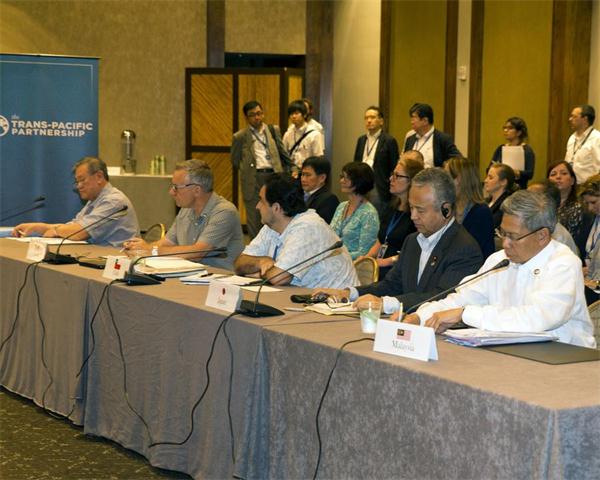
 |
|
Nation members of the Trans-Pacific Partnership (TPP) hold a meeting in Lahaina, Maui, Hawaii July 28, 2015. Pacific Rim officials meet in Hawaii this week for talks that could make or break an ambitious trade deal which aims to boost growth and set common standards across a dozen economies ranging from the United States to Brunei. [Photo/Agencies] |
Last week, trade ministers of 12 Pacific Rim countries, 650 officials, lobby groups and other stakeholders met in Hawaii to conclude the Trans-Pacific Partnership agreement. But the talks failed.
The disagreements in Hawaii do not suggest traditional horse-trading that's typical to all trade bargaining. Rather, the divisions reflect extensive disagreements not only between a dozen TPP countries, but within the US as well.
In the White House, the TPP agreement has been seen as a linchpin of the administration's pivot to Asia, which seeks to embed the US more deeply in the world's most dynamic region, while preventing a "regional vacuum" to be filled by emerging China. The problem is that the first objective is undermined by the second.
During Barack Obama's term in the White House, the US administration has strengthened political and security alliances with Japan, the Republic of Korea and the Philippines. Indirectly, these strategic moves have led to the relaxation of the arms embargo on Vietnam, greater attention to the South China Sea, expansion of counterterrorism cooperation with Indonesia and the upgrading of Malaysia's checks to stop human trafficking. The US has also normalized relations with Myanmar, a pivotal nation at the crossroads of South, East and Southeast Asia.
And yet the South China Sea has seen more friction, terrorist activities have increased, and human trafficking, and division and refugee flows in Myanmar have continued. Add to that the increasing assertiveness of countries, and you get a picture of overall destabilization in the region.
The US' objectives share a common denominator to extend current alliance arrangements in (non-China) East Asia to South and Southeast Asia. These efforts are not easily achievable because of regional and national policies.
The Association of Southeast Asian Nations seeks to hedge between declining US influence and rising Chinese participation. It does not favor the exclusive primacy of one or another large economy. The same goes for India.
First, national policies work against containment policies. While the ROK supports the TPP, it has strong ties with China, an independent foreign policy and historical friction with Japan. In turn, Vietnam's regional stance relies on US clout but is counterbalanced by the desire to sustain expansive economic ties with China.
Second, the TPP bloc is not inclusive. It excludes the three largest emerging economies of the 21st century: China, India and Indonesia. That does not serve the future of the TPP, the region or the US.
Third, the TPP represents preferential rather than free trade and it is punitive to non-members. It may entrench protection in certain key areas, especially agriculture. And thanks to defensive geopolitical stances, current sheltered sectors - Japanese rice, US sugar - may prove even more resistant to change.
As the TPP imposes standards and rules that are inappropriate to the stage of development of emerging economies, it has potential to freeze rather than speed up their development.
So what are China's TPP options in the near future?
China is internationalizing via huge regional initiatives (for instance, the Asian Infrastructure Investment Bank, BRICS New Development Bank and the "Belt and Road Initiative") and bilateral free trade agreements with TPP members Singapore, Chile, Peru, New Zealand and, most recently, Australia. There are also overlaps between TPP and the Regional Comprehensive Economic Partnership, which is led by China with half a dozen TPP members, including Japan.
China may join the TPP at a later point but only when it makes economic and strategic sense.
What about Washington's TPP options? Before the Hawaii meeting, the Obama administration touted it as a make-or-break moment. But that was not to be given the nature of the TPP.
The optimistic TPP scenario is now history. While the agreement could still materialize in some form, it is about to be trumped (all puns intended) by the US presidential politics; the Federal Reserve's impending rate hike, which has potential to further divide US allies (especially emerging economies); and the expected rise of the Chinese yuan to a major reserve currency, heralding de-dollarization in the future.
When and if the TPP will be completed, economic gains will be moderate. But a TPP without China would have substantial geopolitical implications.
Truly inclusive, free trade is a different story. But that's not what the TPP is about.
The author is research director of International Business at India China and America Institute (US) and visiting fellow at Shanghai Institutes for International Studies (China) and the EU Center (Singapore).
Courtesy: chinausfocus.com













